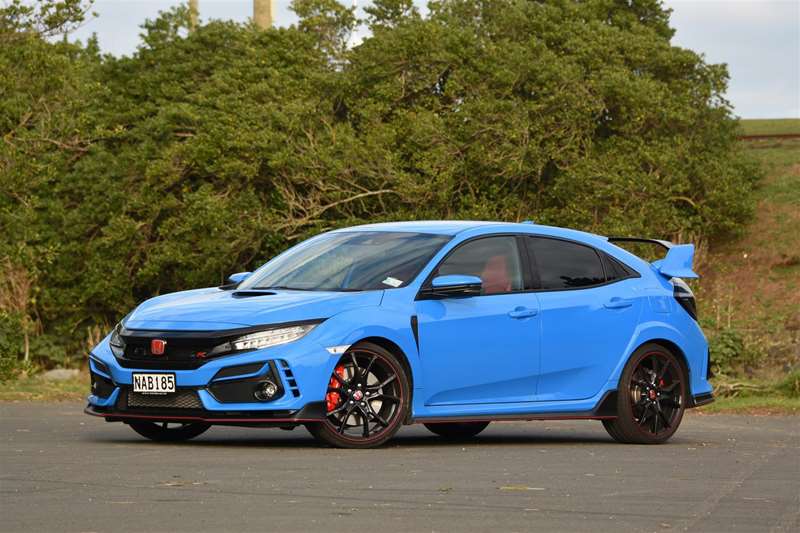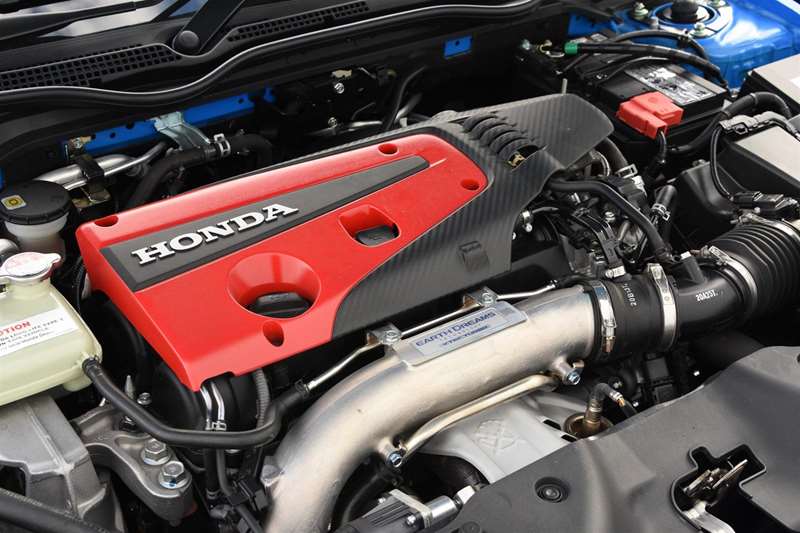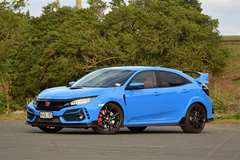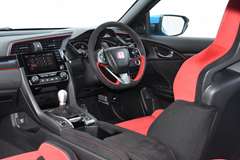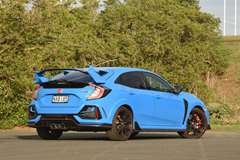Five years after it broke cover to rave reviews, the current iteration of Honda’s Civic Type-R has reached the end of its production run and is now sold out. David Thomson takes it for a first and final fling.
What’s new?
“What are you driving over the long weekend?” a motoring-minded buddy asked me a few days out from the Queen’s Birthday break.
My reply — “a Honda Civic” — was met with silence, broken by the disappointed utterance of a single word: “Oh”.
“Type-R”, I added after a moment.
This time my friend’s response was immediate and much more positive:
“Well that’s different then.”
And so it assuredly is.
In its various regular guises, the Honda Civic is a capable, but determinedly middle-of-the-road compact hatchback. Ideal for a low-key, fuss-free, but not especially memorable long weekend of motoring.
Dressed up in an outrageous body-kit, equipped with specialist sports suspension, and powered by a 2-litre turbo engine with power outputs that push the boundary of what a front-drive system can sanely handle, the Civic Type-R is an altogether different proposition.
Compared to that grandaddy of all hot hatches, the VW Golf GTI, it may be a Johnny-come-lately to the scene, but the Civic Type-R has quickly become an icon in its own right.
The Civic’s journey to hot-hatch stardom started with a Japanese-market Type-R in 1997, but from 2001 the reach became international, with Type-R Civics also produced at Honda’s Swindon plant in the UK.
The current iteration first appeared in 2017, developed as part of the 10th-generation Civic range. It features an improved version of its predecessor’s 2.0-litre turbo engine, now producing 228kW of power and 400Nm of torque, and maintains an established Type-R tradition in only coming with manual transmission.
While the car Honda supplied for this test was one of the last to arrive in the country, it was the first current Type-R to pass through Drivesouth’s hands.
What’s it like to look at?
Viewing the Type-R exterior makeover first-hand, there is a lot to take in.
The look is visually brash and appealing in a boy-racer way.
Key features include carbon fibre splitters and side-skirts, numerous extra air intakes (including one atop the bonnet), and a large rear wing with prominent side strakes. The wheel arches are bulged to accommodate 20-inch alloys shod with 245/30 R20 tyres and triple tailpipes adorn the rear.
The test car was finished in the vibrant blue paint scheme that was introduced (along with an enlarged grille for improved cooling, and new two-piece front brake discs) especially for the 2021 model year.
What’s it like inside?
Though more subtle in its execution that the exterior, the Type-R’s cabin still manages a fine job of combining a seriously sporting sense of occasion with the practical carrying capacity of a regular Civic hatch.
The interior is trimmed predominantly in black and with red highlighting extending to the trim accents, stitching, seat belts and whole sections of the actual seats.
Embossed with Type-R logos, the front seats are super-snug sports buckets. The 2021 addition of alacantra trim to the steering wheel and a reshaped gear knob add to the tactile delight.
The driving position is set low, the gear-lever falls naturally to hand, and the drilled-alloy pedals are nicely spaced. A rocker switch beside the gear lever enables selection between comfort, sport and the most aggressive +R drive mode.
A digital main instrument cluster allows for extensive customisation of the key information displayed to the driver. It’s a whole lot better than the centre touchscreen, which is small by contemporary standards, and has a dated ICT interface and display system.
What comes as standard?
The Type-R is fairly well provisioned with standard creature comforts and convenience features.
Satellite navigation is the obvious exclusion; Honda expects its owners to use smartphone mirroring to access such information from the phone.
The safety suite embraces adaptive radar cruise control, automatic emergency braking, lane departure warning, automatic high beam assistance, blind spot monitoring and cross-traffic alert, and parking sensors front and rear.
What’s it like to drive?
A push of the start button while the clutch is depressed brings the engine to life, and it takes only a few gear changes to appreciate that the tactile delight apparent when the Type-R is parked, is enhanced once under way.
Sport mode is the default setting on start-up, but comfort mode — in which the suspension is remarkably compliant for a car of this sort — is ideal for round-town motoring and everyday highway cruising. As well as softening the suspension damping, this mode lightens the steering and dials back the aggression of the throttle, though not to the point at which the Type-R’s snappy overtaking capability is seriously diminished.
Sport mode is the natural choice for more focused driving, while +R mode firms the damping, adds heft to the steering, and makes the rev-match system even more responsive for faster down shifting. It’s also possible to deactivate the stability and traction control systems in +R mode, though this is an option best left for the track.
With time in hand on a long weekend that involved a return journey from Dunedin to Southland, I was able to maximise driving opportunities on winding and lightly-trafficked tarmac routes that played to the Type-R’s dynamic strengths.
There’s road noise aplenty on coarse chip seal, the ride certainly firms up in sport mode, and even more so for +R, but it’s only in the latter mode that the test car feels a shade too firm for comfortable open road motoring.
Equally, it would be a mistake to interpret the Type-R’s capacity to generate wheelspin in each of its first three gears as representing the limits of how much power and torque may be wisely delivered to the front wheels of a road car; even when accelerating hard, it’s a fully controllable machine.
Powering up through the gears is great fun, as much due to the delightful weight and short throw of the six-speed manual gearbox as the amount of power on offer.
Aided by its rev-matching electronic protocols, downshifting is satisfying too. Throttle response is outstanding, and the accompanying mechanical sound track (artificially augmented via the sound system) is decent.
All this accepted, corners are where the dynamic components that make the Type-R a memorable and hugely accomplished hot-hatch come together.
Alongside the considerable stopping power provided by the car’s big discs and Brembo front callipers, the amount of feel provided through the brake pedal and consequent ability to balance the car under braking, is exceptional. In similar vein, the steering is both precise and well-weighted. Aided by several suspension tweaks introduced this year, the Type-R’s composure when cornering briskly is also exemplary. Chassis pitch under braking is minimal, body roll neatly contained.
Combine these attributes with high levels of grip, the role its mechanical limited slip differential plays in delivering excellent on-throttle adjustability, and the Type-R excels as a lithe and agile machine manoeuvrable through any bends.
While it shines in the dry, I was struck by the Type-R’s ability to delight and inspire confidence on wet and gritted tarmac. Equally, while this hottest of all Civics delivers the greatest rewards when inputs come via the steering wheel, the brake pedal and accelerator are thoughtful and nuanced and it is quite forgiving when driven imprecisely.
Verdict?
There’s one final chapter in the petrol-powered Type-R yet to play out, with a new model under development for release as part of the upcoming 11th generation Civic range.
The current model sets an enviable benchmark for its successor. Consistent with rating as one of the greatest hot hatches of recent times, it also rates as the most engaging and accomplished sports machine to have passed through my hands in well over a year.
Photos: David Thomson
